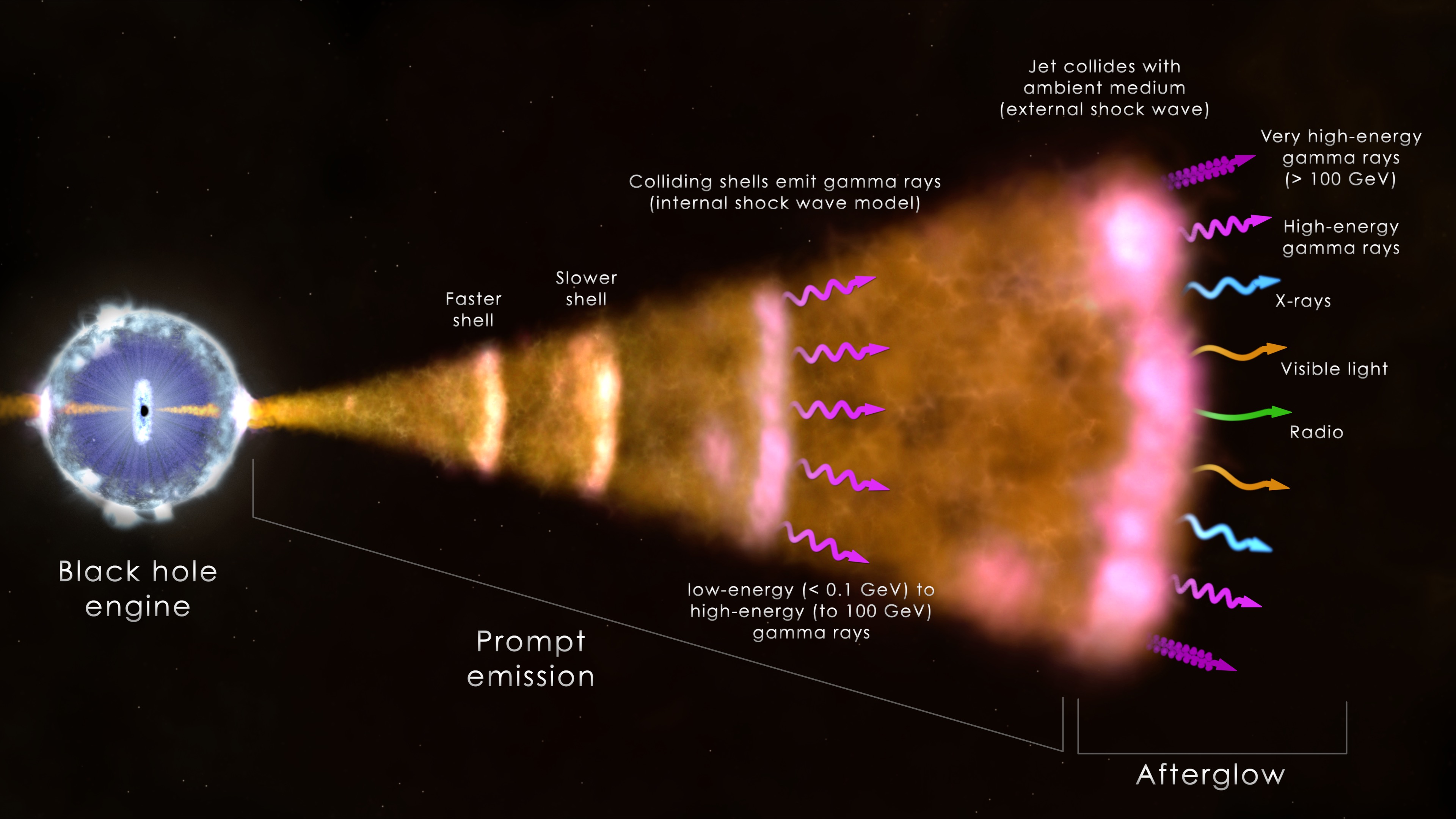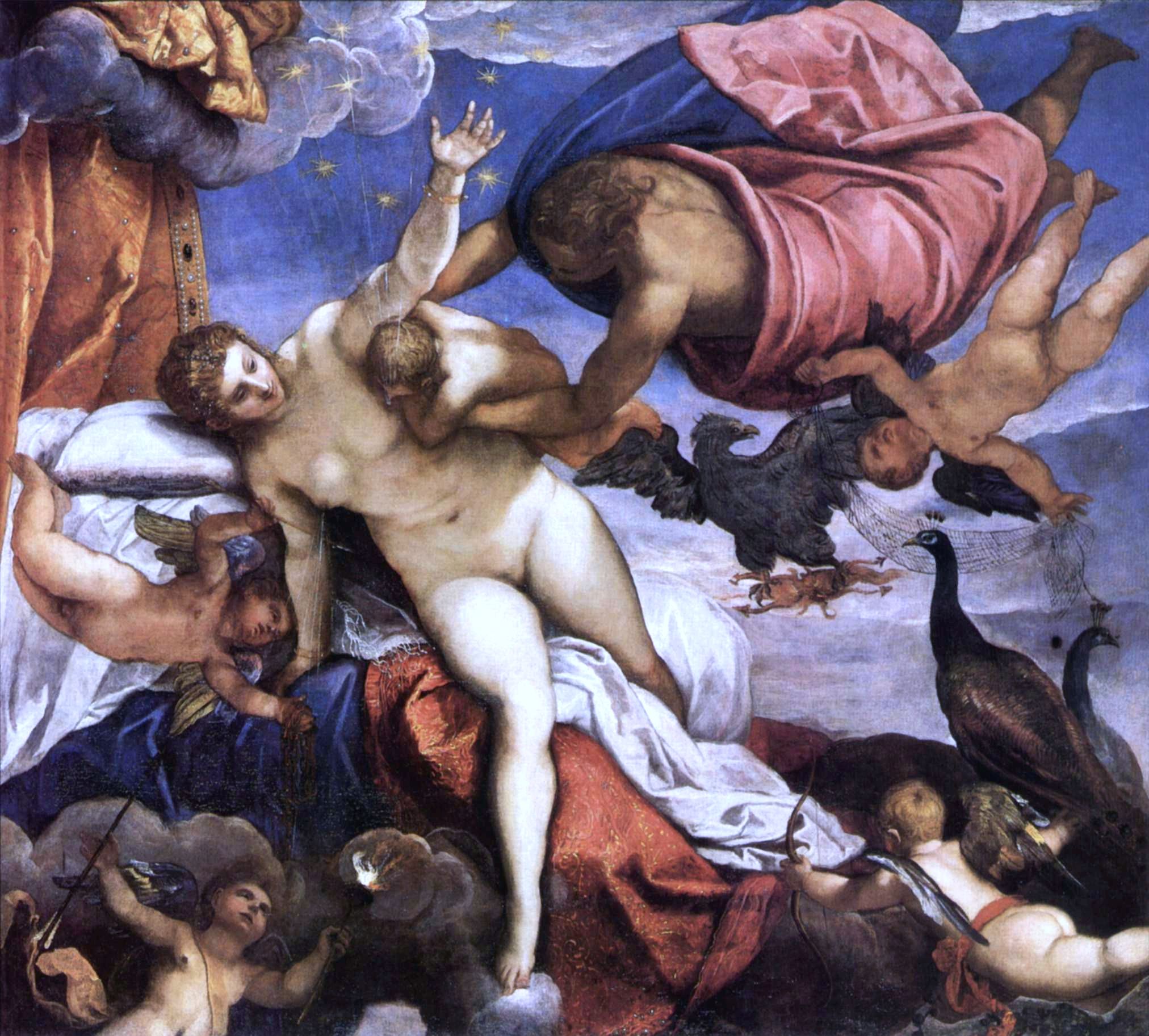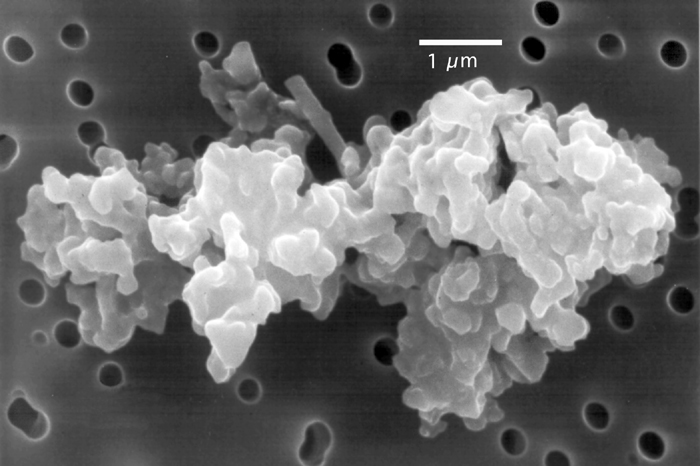|
Gamma-ray Burst Emission Mechanisms
Gamma-ray burst emission mechanisms are theories that explain how the energy from a gamma-ray burst progenitor (regardless of the actual nature of the progenitor) is turned into radiation. These mechanisms are a major topic of research as of 2007. Neither the light curves nor the early-time spectra of GRBs show resemblance to the radiation emitted by any familiar physical process. Compactness problem It has been known for many years that ejection of matter at relativistic velocities (velocities very close to the speed of light) is a necessary requirement for producing the emission in a gamma-ray burst. GRBs vary on such short timescales (as short as milliseconds) that the size of the emitting region must be very small, or else the time delay due to the finite speed of light would "smear" the emission out in time, wiping out any short-timescale behavior. At the energies involved in a typical GRB, so much energy crammed into such a small space would make the system opaque to photon-ph ... [...More Info...] [...Related Items...] OR: [Wikipedia] [Google] [Baidu] |
Gamma-ray Burst Progenitors
Gamma-ray burst progenitors are the types of celestial objects that can emit gamma-ray bursts (GRBs). GRBs show an extraordinary degree of diversity. They can last anywhere from a fraction of a second to many minutes. Bursts could have a single profile or oscillate wildly up and down in intensity, and their spectra are highly variable unlike other objects in space. The near complete lack of observational constraint led to a profusion of theories, including evaporating black holes, magnetic flares on white dwarfs, accretion of matter onto neutron stars, antimatter accretion, supernovae, hypernovae, and rapid extraction of rotational energy from supermassive black holes, among others. There are at least two different types of progenitors (sources) of GRBs: one responsible for the long-duration, soft-spectrum bursts and one (or possibly more) responsible for short-duration, hard-spectrum bursts. The progenitors of long GRBs are believed to be massive, low-metallicity stars exploding ... [...More Info...] [...Related Items...] OR: [Wikipedia] [Google] [Baidu] |
Relativistic Particle
A relativistic particle is a particle which moves with a relativistic speed; that is, a speed comparable to the speed of light. This is achieved by photons to the extent that effects described by special relativity are able to describe those of such particles themselves. Several approaches exist as a means of describing the motion of single and multiple relativistic particles, with a prominent example being postulations through Dirac equations of single particle motion. Massive particles are relativistic when their kinetic energy is comparable to or greater than the energy mc^2 corresponding to their rest mass. In other words, a massive particle is relativistic when its total mass-energy (rest mass + kinetic energy) is at least twice its rest mass. This condition implies that the particle's speed is close to the speed of light. According to the Lorentz factor formula, this requires the particle to move at roughly 85% of the speed of light. Such relativistic particles are g ... [...More Info...] [...Related Items...] OR: [Wikipedia] [Google] [Baidu] |
Lyman Break
Lyman may refer to: Places Ukraine * Lyman, Ukraine United States * Lyman, Iowa * Lyman, Maine * Lyman, Mississippi * Lyman, Nebraska * Lyman, New Hampshire * Lyman, Oklahoma * Lyman, South Carolina * Lyman, South Dakota * Lyman County, South Dakota * Lyman, Utah * Lyman, Washington * Lyman, Wyoming Other uses * Lyman (crater), a lunar impact crater * Lyman (name) * Lyman series In physics and chemistry, the Lyman series is a hydrogen spectral series of transitions and resulting ultraviolet emission lines of the hydrogen atom as an electron goes from ''n'' ≥ 2 to ''n'' = 1 (where ''n'' is the princ ... of hydrogen spectral lines See also * Liman (other) * Lyman High School (other) * {{disambiguation, geo ... [...More Info...] [...Related Items...] OR: [Wikipedia] [Google] [Baidu] |
Milky Way
The Milky Way is the galaxy that includes our Solar System, with the name describing the galaxy's appearance from Earth: a hazy band of light seen in the night sky formed from stars that cannot be individually distinguished by the naked eye. The term ''Milky Way'' is a translation of the Latin ', from the Greek ('), meaning "milky circle". From Earth, the Milky Way appears as a band because its disk-shaped structure is viewed from within. Galileo Galilei first resolved the band of light into individual stars with his telescope in 1610. Until the early 1920s, most astronomers thought that the Milky Way contained all the stars in the Universe. Following the 1920 Great Debate between the astronomers Harlow Shapley and Heber Curtis, observations by Edwin Hubble showed that the Milky Way is just one of many galaxies. The Milky Way is a barred spiral galaxy with an estimated D25 isophotal diameter of , but only about 1,000 light years thick at the spiral arms (more at the ... [...More Info...] [...Related Items...] OR: [Wikipedia] [Google] [Baidu] |
Interstellar Dust
Cosmic dust, also called extraterrestrial dust, star dust or space dust, is dust which exists in outer space, or has fallen on Earth. Most cosmic dust particles measure between a few molecules and 0.1 mm (100 micrometers). Larger particles are called meteoroids. Cosmic dust can be further distinguished by its astronomical location: intergalactic dust, interstellar dust, interplanetary dust (such as in the zodiacal cloud) and circumplanetary dust (such as in a planetary ring). There are several methods to obtain space dust measurement. In the Solar System, interplanetary dust causes the zodiacal light. Solar System dust includes comet dust, asteroidal dust, dust from the Kuiper belt, and interstellar dust passing through the Solar System. Thousands of tons of cosmic dust are estimated to reach the Earth's surface every year, [...More Info...] [...Related Items...] OR: [Wikipedia] [Google] [Baidu] |
Protons
A proton is a stable subatomic particle, symbol , H+, or 1H+ with a positive electric charge of +1 ''e'' elementary charge. Its mass is slightly less than that of a neutron and 1,836 times the mass of an electron (the proton–electron mass ratio). Protons and neutrons, each with masses of approximately one atomic mass unit, are jointly referred to as "nucleons" (particles present in atomic nuclei). One or more protons are present in the nucleus of every atom. They provide the attractive electrostatic central force which binds the atomic electrons. The number of protons in the nucleus is the defining property of an element, and is referred to as the atomic number (represented by the symbol ''Z''). Since each element has a unique number of protons, each element has its own unique atomic number, which determines the number of atomic electrons and consequently the chemical characteristics of the element. The word ''proton'' is Greek for "first", and this name was given ... [...More Info...] [...Related Items...] OR: [Wikipedia] [Google] [Baidu] |
Electrons
The electron (, or in nuclear reactions) is a subatomic particle with a negative one elementary electric charge. Electrons belong to the first generation of the lepton particle family, and are generally thought to be elementary particles because they have no known components or substructure. The electron's mass is approximately 1/1836 that of the proton. Quantum mechanical properties of the electron include an intrinsic angular momentum ( spin) of a half-integer value, expressed in units of the reduced Planck constant, . Being fermions, no two electrons can occupy the same quantum state, per the Pauli exclusion principle. Like all elementary particles, electrons exhibit properties of both particles and waves: They can collide with other particles and can be diffracted like light. The wave properties of electrons are easier to observe with experiments than those of other particles like neutrons and protons because electrons have a lower mass and hence a longer ... [...More Info...] [...Related Items...] OR: [Wikipedia] [Google] [Baidu] |
Stellar Wind
A stellar wind is a flow of gas ejected from the upper atmosphere of a star. It is distinguished from the bipolar outflows characteristic of young stars by being less collimated, although stellar winds are not generally spherically symmetric. Different types of stars have different types of stellar winds. Post- main-sequence stars nearing the ends of their lives often eject large quantities of mass in massive ( \scriptstyle \dot > 10^ solar masses per year), slow (v = 10 km/s) winds. These include red giants and supergiants, and asymptotic giant branch stars. These winds are understood to be driven by radiation pressure on dust condensing in the upper atmosphere of the stars. Young T Tauri stars often have very powerful stellar winds. Massive stars of types O and B have stellar winds with lower mass loss rates (\scriptstyle \dot 1–2000 km/s). Such winds are driven by radiation pressure on the resonance absorption lines of heavy elements such as carbo ... [...More Info...] [...Related Items...] OR: [Wikipedia] [Google] [Baidu] |
Interstellar Medium
In astronomy, the interstellar medium is the matter and radiation that exist in the space between the star systems in a galaxy. This matter includes gas in ionic, atomic, and molecular form, as well as dust and cosmic rays. It fills interstellar space and blends smoothly into the surrounding intergalactic space. The energy that occupies the same volume, in the form of electromagnetic radiation, is the interstellar radiation field. The interstellar medium is composed of multiple phases distinguished by whether matter is ionic, atomic, or molecular, and the temperature and density of the matter. The interstellar medium is composed, primarily, of hydrogen, followed by helium with trace amounts of carbon, oxygen, and nitrogen. The thermal pressures of these phases are in rough equilibrium with one another. Magnetic fields and turbulent motions also provide pressure in the ISM, and are typically more important, dynamically, than the thermal pressure is. In the interstellar medium ... [...More Info...] [...Related Items...] OR: [Wikipedia] [Google] [Baidu] |






